Metallocenes as Target Specific Drugs for Cancer Treatment
- PMID: 23180884
- PMCID: PMC3501760
- DOI: 10.1016/j.ica.2012.06.007
Metallocenes as Target Specific Drugs for Cancer Treatment
Abstract
The application use of organometallic compounds into the cancer research was established in the late 1970s by Köpf-Maeir and Köpf. This new research area has been developed for the past thirty years. In the early 1980s, Jaouen and coworkers recognized the potential application of organometallic compounds vectorized with pendant groups that can deliver the drug to certain specific receptors. This is what is called nowdays Target Specific Drugs. This review will focus on metallocenes vectorized with steroids derivatives of hormones, nonsteroidal and selective endrocrine modulator.
Figures













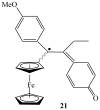
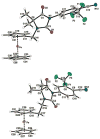

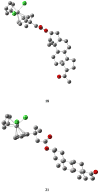




 are estradiol ferrocenoylate (of ferrocenoyl 17β-hydroxy-estra-1,3,5(10)-trien-3-olate),
are estradiol ferrocenoylate (of ferrocenoyl 17β-hydroxy-estra-1,3,5(10)-trien-3-olate),
 is the nucleus.
is the nucleus.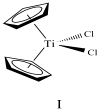
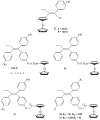


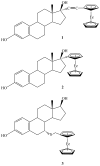
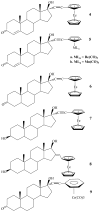
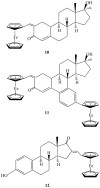



Similar articles
-
Bioorganometallic Chemistry of Molybdenocene Dichloride and Its Derivatives.J Organomet Chem. 2012 Jun 1;706-707:4-12. doi: 10.1016/j.jorganchem.2012.02.006. Epub 2012 Feb 6. J Organomet Chem. 2012. PMID: 22605891 Free PMC article.
-
Alkaline earth metallocenes coordinated with ester pendants: synthesis, structural characterization, and application in metathesis reactions.Chemistry. 2013 Sep 16;19(38):12859-66. doi: 10.1002/chem.201301618. Epub 2013 Aug 9. Chemistry. 2013. PMID: 23934787
-
New Ferrocene Compounds as Selective Cyclooxygenase (COX-2) Inhibitors: Design, Synthesis, Cytotoxicity and Enzyme-inhibitory Activity.Anticancer Agents Med Chem. 2018;18(2):295-301. doi: 10.2174/1871520617666171003145533. Anticancer Agents Med Chem. 2018. PMID: 28971779
-
Recent Advances of Metallocenes for Medicinal Chemistry.Mini Rev Med Chem. 2017;17(9):771-784. doi: 10.2174/1389557516666161031141620. Mini Rev Med Chem. 2017. PMID: 27804886 Review.
-
Strategies for the Synthesis of Chiral Carbon-Bridged Group IV ansa-Metallocenes.Chemistry. 2019 Aug 9;25(45):10531-10545. doi: 10.1002/chem.201901505. Epub 2019 Jun 21. Chemistry. 2019. PMID: 31059590 Review.
Cited by
-
Anticancer Tungstenocenes with a Diverse Set of (O,O-), (O,S-) and (O,N-) Chelates-A Detailed Biological Study Using an Improved Evaluation via 3D Spheroid Models.Pharmaceutics. 2023 Jul 3;15(7):1875. doi: 10.3390/pharmaceutics15071875. Pharmaceutics. 2023. PMID: 37514061 Free PMC article.
-
Para-Substituted Functionalised Ferrocene Esters with Novel Antibacterial Properties.J Clin Diagn Res. 2018 Feb;12(2):DC01-DC04. doi: 10.7860/JCDR/2018/30149.11218. J Clin Diagn Res. 2018. PMID: 29780759 Free PMC article.
-
A new ferrocene derivative blocks K-Ras localization and function by oxidative modification at His95.Life Sci Alliance. 2023 Sep 4;6(11):e202302094. doi: 10.26508/lsa.202302094. Print 2023 Nov. Life Sci Alliance. 2023. PMID: 37666666 Free PMC article.
-
Mass Spectrometric Evaluation of β-Cyclodextrins as Potential Hosts for Titanocene Dichloride.Int J Mol Sci. 2021 Sep 10;22(18):9789. doi: 10.3390/ijms22189789. Int J Mol Sci. 2021. PMID: 34575951 Free PMC article.
-
Enantiomerically Pure ansa-η5-Complexes of Transition Metals as an Effective Tool for Chirality Transfer.Molecules. 2025 Jun 8;30(12):2511. doi: 10.3390/molecules30122511. Molecules. 2025. PMID: 40572477 Free PMC article. Review.
References
-
- Köpf H, Köpf-Maier P. Angew Chem Int Ed Engl. 1979;18:477–478. - PubMed
-
- Köpf-Maier P. Eur J Clin Pharmacol. 1994;47:1–16. - PubMed
-
- Köpf-Maier P, Köpf H. Structure and Bonding. 1988;70:103.
-
- Köpf-Maier P, Köpf H. Chem Rev. 1987;87:1137–1152.
-
- Köpf-Maier P, Köpf H. In: Metal Compounds in Cancer Therapy, Organometallic Titanium, Vanadium, Niobium, Molybdenum and Rhenium Complexes - Early Transition Metal Anti-tumor Drugs. Fricker SP, editor. Chapman and Hall; London: 1994. pp. 109–146.
Grants and funding
LinkOut - more resources
Full Text Sources
Miscellaneous
